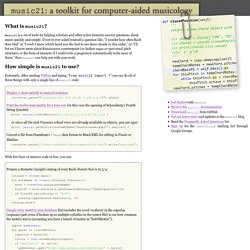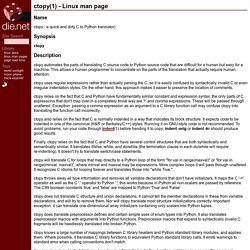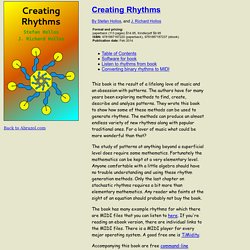

Musical Chord Progression Arpeggiator. Granular Synthesis EXPLAINED. Johnfromberkeley's lists. iOS music.
Linux apps. Clojure/pink/overtone. What is Polychromatic Music? - An introduction with comparison of modern microtonal instruments. Sonic Pi - The Live Coding Music Synth for Everyone. AATranslator - Home Page. Sound and Music Applications. Next: Pd and externalsUp: The Planet CCRMA package Previous: A roadmap for Planet Subsections Here is the sound and music applications rpm collection.

Each application comes with a yum incantation that will hopefully get it (and everything else it needs and you don't have) installed. Under the heading ``Packages'' you will find direct links to the source and binary rpms as well, for both Planet CCRMA packages and packages that have migrated to Fedora or other repositories. Snd Latest version Bill Schottstaedt says: ``Snd is a sound editor modelled loosely after Emacs and an old, sorely-missed PDP-10 sound editor named Dpysnd. To install Snd and the snd utilities type: If you want to install the GTK gui version of snd: The GTK based executable is "/usr/bin/snd-gtk". ManPages: snd. The On-Line Encyclopedia of Integer Sequences® (OEIS®) Music21: a Toolkit for Computer-Aided Musicology.
Version 3 of music21 is here!

This is the first major release in 11 months, with nearly 600 commits since the last version. As a new major version, there are both huge new features as well as significant (often backwards incompatible) changes. Upgrades for most users should work automatically by typing: pip3 install --upgrade music21 or (Python 2) pip install --upgrade music21 Or download from GitHub A summary of the most important changes since v.2.2 are below: Fun and easy to understand changes:Lots more MusicXML support -- better support for time signatures, for grace notes, for spanners, for metadata, for...you name it!
Roland_Kuit:SoundLab I. Source: electro-music.com From Data Recovery, USA: Roland's synthesis tutorial is hands down the best reference for the Nord G2.

Period. It also serves as an outstanding resource and workbook for general synthesis. All the concepts covered in SoundLab can easily be applied to Max, Reaktor, or whatever you use. From Memmorshell. Now I have had this tutorial for a few weeks, I just wanted to say that it is really an amazing source of information.
From Drumfish, France: I am so impressed of the work you have done in this tutorial..........just amazing really. Axoloti : a digital audio platform for makers. A new solution to create your own digital synthesizer, effects unit, groovebox or stomp-box, quick and easy.

With the Axoloti Patcher on your computer you can program your sound, composition, and interaction by selecting objects like oscillators, filters, envelopes from the object library: An Enabling Encoding for Media Applications. Felix's Machines. Ctopy(1): quick/dirty C to Python translator) Name ctopy - a quick and dirty C to Python translator) Synopsis ctopy Description ctopy automates the parts of translating C source code to Python source code that are difficult for a human but easy for a machine.

Ctopy uses regular expressions rather than actually parsing the C, so it is easily confused by syntactically invalid C or even irregular indentation styles. Ctopy relies on the fact that C and Python have fundamentally similar constant and expression syntax; the only parts of C expressions that don't map over in a completely trivial way are ?
Ctopy also relies on the fact that C is normally indented in a way that indicates its block structure. Finally, ctopy relies on the fact that C and Python have several control structures that are both syntactically and semantically similar. Ctopy will translate C for loops that map directly to a Python loop of the form "for var in range(maxval)" or "for var in range(minval, maxval)", where minval and maxval may be expressions. Type <name> Bugs. Creating Rhythms. This book is the result of a lifelong love of music and an obsession with patterns.

The authors have for many years been exploring methods to find, create, describe and analyze patterns. They wrote this book to show how some of these methods can be used to generate rhythms. The methods can produce an almost endless variety of new rhythms along with popular traditional ones. For a lover of music what could be more wonderful than that? The study of patterns at anything beyond a superficial level does require some mathematics. The book has many example rhythms for which there are MIDI files that you can listen to here. Accompanying this book are free command-line programs for doing calculations and creating rhythms.
You can get this book now at Amazon. You can also get this book instantly as a pdf from Gumroad where you will be able to download it immediately after purchase. About the authors: Stefan Hollos and J. Table of Contents. Computer Music Resources: MBS FirstClass. Typedrummer. A guide to electronic music.
Hardware. Blogs n lists. Organizations and universties. Articles on ... Computer music techniques. Commands (GNU/Linux UNIX) Code contributors. Software. Synths. Electronic Music Know How. Samples sources.